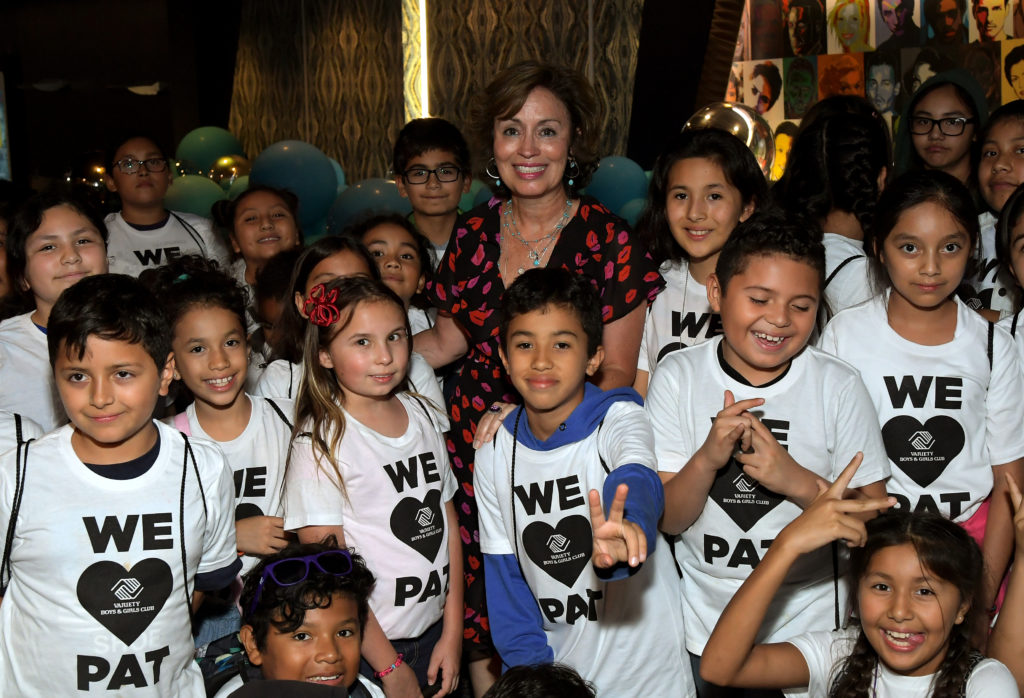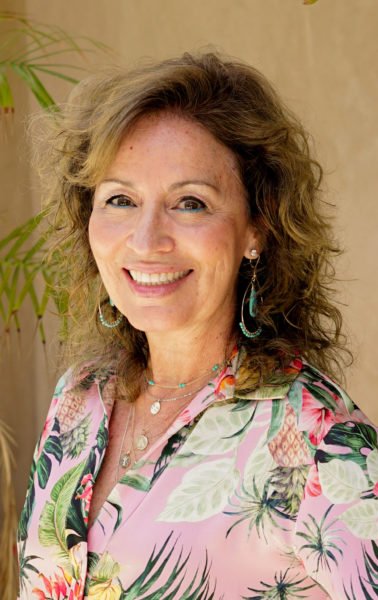A love of the movies runs deep for Pat Gonzalez, SVP of in-theater marketing at Paramount Pictures. A child of Los Angeles, she grew up as a regular at the Egyptian Theatre, where her introduction to the art form in which she would eventually establish a 40-year career came, not from children’s movies, but from capital-C Classics that were not always the most appropriate viewing for a child not yet in middle school.
“I was one of those younger girls hanging out with older cousins,” Gonzalez recalls. “At 9 years old, I was a chaperone for my cousin, 17, and her boyfriend—at the time, 19. When they went out to the movies, they took me. So I saw movies that were very much out of my age range. I saw the Godfather at age 9.”
Such an early exposure to, say, The Godfather’s horse-head scene (“I couldn’t get that out of my mind”) could have turned young Pat off film for good. Fortunately, her childhood moviegoing experiences were mostly thrilling, with the classic old movie houses of L.A. serving as the source of a cinema obsession that continues to this day. “I wasn’t, probably, in a multiplex until I was a teenager,” she recalls. Gonzalez will take a black-and-white movie over a color one. The Hepburns—Audrey and Katharine—are her actresses of choice, along with the great Myrna Loy. For the men, it’s Clark Gable. And as for big screen vs. small—the answer should be obvious.
“It was at a time when it was safe. You could walk places,” recalls Gonzalez of her Hollywood childhood. “I was allowed to walk to Hollywood Boulevard to go to the movies.” Butch Cassidy and the Sundance Kid, The Sting, The Heartbreak Kid, and Jeremiah Johnson were early favorites, along with the road comedies of Bob Hope and Bing Crosby. “It is such a different way to see a movie, right when you walk in,” says Gonzalez of her early years haunting the Egyptian, the Mann’s Chinese Theatre, and classic cinemas dotted around Westwood. “In those theaters, you feel so small. Especially as a kid. And it’s this big, enormous picture—it does suck you in. I love the way that we see movies today. But there is something really special about the throwback of seeing them on those big screens, where you had eight, nine hundred people in one auditorium seeing a big movie.”
It made sense that someone who spent so much time in theaters would eventually get a job in one—which Gonzalez did, at a General Cinema location, where, starting at age 17, she worked the concession stand one day a week. One day turned into five, then six. Gonzalez was “enamored by that whole experience,” she says, and her plans of being a graphic designer fell by the wayside.
It surely didn’t hurt that the cinema where Gonzalez started her entertainment career played host to extensive audience research screenings—she estimates 250 a year. “You had Julia Roberts, Richard Gere. It was a constant influx of talent for research screenings and also just hanging out and coming to the movies.”
Gonzalez moved to the corporate side of General Cinema, eventually becoming their national director of film marketing. She would work on the exhibition side of the business for 16 years before moving over to DreamWorks—where she was the head of theatrical marketing services until 2006—and then Paramount Pictures. Regardless of the company she worked for, or whether she was on the distribution or the exhibition side, her goal was the same: getting people into theaters. Working creatively to do just that was the part of her time at General Cinema that she loved the most. “We did a lot together collectively as a staff,” she says. “If we knew that Universal’s coming in, and they were doing a big research screening, I’d get our team together: ‘Listen, Backdraft is opening. Let’s do this really amazing still life with set pieces and tie-ins with the local fire station.’ You’d be collaborating and actually creating something that would create a focal point.”
In working on the exhibitor side of in-theater marketing, Gonzalez would collaborate with studios—though, at the time, “exhibitor relations” was still coming into being as a distinct role. “Way back in the day, there wasn’t a department at an exhibition company programming the trailers. It would have been myself or anybody else that was the manager of that complex—we would be programming our screens. And as things got more … I’m going to say competitive, and you had everybody vying to get on-screen, it actually got taken out of the individual theaters and became a home office responsibility. But back in the day, in the ’80s, there were maybe two or three people doing what, today, you might have 100 people doing.”
Whether it’s two people or 100, distributor or exhibitor: “Whatever we do, we have to continue to elevate the theatrical experience. Showmanship has always been important. But I feel like it’s even more important today than ever before.”
What does that mean in the post-Covid era, when exhibitors and studios, filmmakers and talent, must work together to remind moviegoers of how powerful the cinema experience can be—when the resources for a big, splashy spend may not be there? “What can you do that becomes a little bit more turnkey yet feels special?” Gonzalez asks. She offers up as an example an event around Paramount’s A Quiet Place Part II, where a Thursday preview screening at the Cinemark Playa Vista and XD featured a live Q&A with director John Krasinski, simulcast to over 500 theaters across the country.
“Our big thing was, how do you bring this experience and not charge anything extra for it? For this event, it’s the regular price of admission,” says Gonzalez. “These things—they were important before the pandemic, but I think it’s really even more important now. We’re doing some taped greetings. We’re doing things to verbally remind people: ‘You’re here. We know it wasn’t easy for you to get out of your house and come to the movie theater. We’re grateful that you’re here.’”
The pandemic may have caused a time of unprecedented, extended precarity in the cinema industry, but championing the experience of seeing movies in theaters is nothing new to Gonzalez and her team, nor is doing so on a shoestring budget. Asked about an underdog film that she’s worked on during her time at Paramount, Gonzalez flashes back to the first Paranormal Activity, the campaign for which memorably (and quite successfully) showcased moviegoers’ terrified in-theater reactions to the horror unspooling on the screen. “It was a small group of us trying to do things in a very nontraditional way,” she says. The film initially opened in 13 markets—not “typical, mainstream theaters,” but more out-of-the-way places and college towns. When they added Santa Cruz, people would drive the five-plus hours from Los Angeles to get there, despite the fact that there were only two screenings per day, one at 10 and the other at midnight.
The experience was, “in the truest sense, about working hand in hand with your exhibitor partners,” says Gonzalez. Promotion was largely by word-of-mouth—no television and a modest digital “Demand It!” campaign, in which those curious about all the fuss could go to the film’s official website and vote for Paranormal Activity to come to their city. If the film got a million votes—which it did, as evidenced by the five-and-counting sequels—it would open nationwide. “It was really the strangest, most fascinating process, but also the most rewarding, because you saw the fruits of the grassroots efforts,” says Gonzalez.
The Paranormal Activity marketing campaign may have been exceptional in its creativity and effectiveness, but every film requires something a little different from the rest—and that’s what Gonzalez likes most about her job. “It’s a constantly changing landscape. We get more involved now in life cycle marketing, because you’re talking about theatrical and the home entertainment piece, and a lot of the exhibitor partners now have [streaming platforms],” she says. “You’re always going to have what I call a traditional marketing mix. And then separate from all that is, what do you do to really step out? What can you do that feels like you’re taking the movie to the next level?” Whatever marketing magic is required to get people to see a particular film, Gonzalez says it’s most important that the programs her team proposes “have to be good for both of us,” studio and theaters. “It can never be one-sided. It has to be good for us and for our exhibitor partners,” she says. “I have fun! At the end of the day, I have fun doing what I do with the team that I get to work with and the people that I work with in exhibition.”

The joy and the pride Gonzalez takes from her work in the entertainment industry extends beyond her work in exhibition and distribution to her years of service with Variety – the Children’s Charity, where she serves on the boards of two chapters: Variety the Children’s Charity of Southern California and Variety Boys & Girls Club of Boyle Heights. “I work with incredible men and women,” she says. “We all have day jobs. But we’re all so motivated by this passion of trying to make the world a little bit better. And one of the ways you can do that is through helping kids and youth, so that everyone has a fair shot at making their dreams come true.”
Through her work with Variety, Gonzalez has seen first-hand the good that the film industry does in providing children who have health challenges the mobility bikes they need. “You give that child a moment to actually feel like other kids feel, things that we all take for granted.” The children who attend the Variety Boys & Girls Club of Boyle Heights, meanwhile, “just take your breath away. They’re such smart kids. This club is in a really tough part of Los Angeles. It’s in the inner city, and it’s surrounded by a lot of gangs—it’s just a tough neighborhood to live in. But that club is a safe haven for all these kids. I’m inspired by the kids and their desire to learn. I’m part of the scholarship review at Variety SoCal. A lot of those kids that get scholarships, they’re the first in their families going off to college.” Once they do, many come back, “because they want to help make their community better. I’m really inspired by that, too.”
“I’ve been very lucky,” Gonzalez says. “I don’t forget how blessed I am. I love this industry.”



Share this post